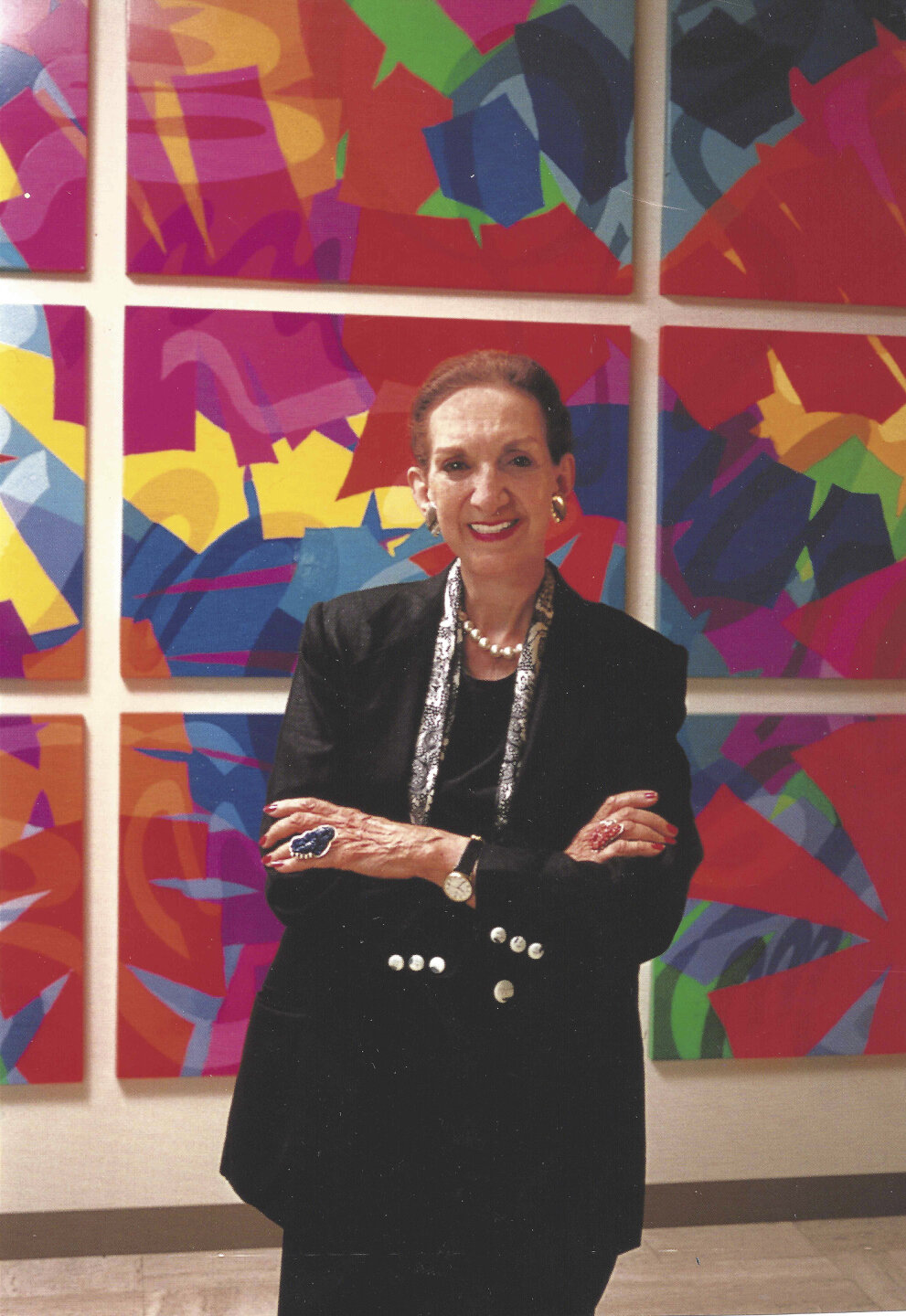Dorothy Gillespie
(1920-2012)
"Seeing in the mind’s eye a vision – then setting up a procedure to produce the vision – then having the courage to let the spiritual core of the human experience come to the fore in that vision; maybe this has something to do with creativity."—Dorothy Gillespie
The Dorothy Gillespie Foundation proudly presents the works and history of the 20th century American Artist, Dorothy Gillespie, which included abstract expressionism, decorative abstraction, site-specific installations, the women's movement and art in public spaces. She was a pioneer in the new directions of metal sculpture and best known for large-scale, highly colorful painted arrangements of cut aluminum strips radiating, undulating, or curling in giant arrangements of ribbon, enchanted towers, and even the burst of fireworks piece: well known as a painter, sculptor and installation artist whose work incorporated many significant 20th-century trends in art.
Dorothy Gillespie's career spanned seven decades, and was always in the forefront of the American Art movement. Ms. Gillespies works have graced and still grace many institutions, museums, colleges, universities and public places. She was one of the first artists to offer her art to the world through displays in the lobbies of public institutions and governmental centers such as the Mayo Clinic, Epcot Center, Warren Wilson College, Fort Lauderdale Airport-Delta Terminal, Thalian Hall Center for the Performing Arts, Fort Lauderdale Museum of Art,St. Marks School-Dallas, United States Mission to the United Nations, Miami Public Library, Court House Square-Roanoke, VA.
The Dorothy Gillespie Foundation invites you to visit the various pages of our website, to learn about her art and who Dorothy Gillespie was, and to view many of her works and collections and take part in the energy and life she created for everyone to admire and enjoy. Her art was always fresh and colorful and Dorothy Gillespie's artistic touch is unequaled.
Biography
“I love color, it goes back to the things I saw as a child – a Christmas tree, a ball bouncing, a kite.”
—Dorothy Gillespie
Dorothy Gillespie’s illustrious career in art spanned over 70 years during which time she created, exhibited and sold her art work nationally and internationally.
Gillespie, born in Roanoke Virginia, declared early her intention to become an artist. She studied art at the Maryland Institute College of Art, Baltimore, MD then moved to New York City where she studied at the Art Student's League of New York and the Stanley William Hayter's Atelier 17.
Among her many honors, Gillespie received The Alice Baber Art Fund, Inc. Grant Award; a Doctor of Pedagogy, Niagara University, Niagara Falls, NY 1990; a Doctor of Fine Arts (Honoris Causa) Caldwell College, Caldwell, NY 1976; an Allied Professions Award,Virginia Society; The American Institute of Architects, Richmond, VA 1986; Distinguished Alumni Award, Maryland Institute, College of Art, Baltimore, MD 1983; Outstanding Services Award, University of Arkansas at Little Rock, AR 1983; and, the Lifetime Achievement Award from the Women’s Caucus for Art in 2001. The Gala 8 " Distinguished Woman" Award at Birmingham Southern College in 1987 honoring women who have made lasting contributions to our society in the fields of endeavor ranging from the arts, medicine, philanthropy, journalism, government, sports, entertainment and business".
In addition to her demanding studio work, Gillespie served as a Distinguished Professor of Art, Radford University, Radford, VA 1997-99; on the Board of Trustees, Maryland Institute, College of Art, Baltimore, MD 1996-99; on the Board of Trustees, Maitland Art Center, Maitland, FL 1996-99; and on the Art in Public Places Committee, Broward Cultural Affairs Council, June 1993-June 1994; and as Visiting Artist, Radford University, Radford, VA 1981-83 where she initiated the University’s permanent art collection through a gift of her own work and where her work is now archived. Woodrow Wilson Visiting Fellow from 1985-1993. During that period she made week-long visits to small private colleges throughout the country and gave public lectures, coached and taught young artists.
Early in her career, Gillespie contributed to the women’s art movement through her work at Artist in Residence, Women's Interart Center, New York, NY 1972 and her lecture series at the New School for Social Research, New York, NY 1977.
Gillespie is the subject of numerous reviews, critical essays, film and radio interviews and a book Dorothy Gillespie published by the Radford University Foundation Press.
Dorothy Gillespie was well known as a painter,sculptor, and installation artist whose work encompassed many significant 20th-century trends in art, including abstract expressionism, decorative abstraction, site-specific installations, the women's movement, and art in public spaces. She pioneered joyful new directions for metal sculpture and is best known for large-scale, colorfully painted arrangements of cut aluminum strips that radiate, undulate, or curl like giant arrangements of ribbon, enchanted towers, or bursting fireworks.
